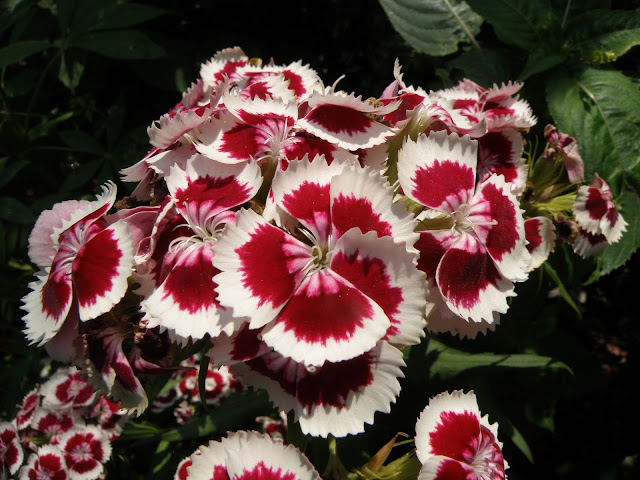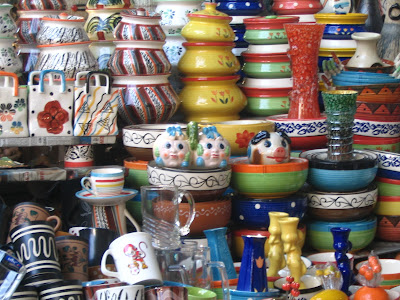The temple town of Kanchipuram, well-known all over the world for its famed silk sarees, is located just about 75 kilometres from Chennai. Connoisseurs of temple architecture can spend days admiring the astonishing display of sculpture and art in the ancient temples. Or one can just make a day trip to get a glimpse of our heritage and history, scattered all over the town in the form of temples big and small. We did the latter.
Our first stop was the sprawling Ekambareswarar Temple Complex. Read more about the temple here. This has been in existence since at least 600 AD. That makes it one of the most ancient temples in South India. The main hall with pillars is very impressive. As is the practice in this part of the world, it gets darker and darker when you get closer to the sanctum sanctorum. The deity is visible for just a few seconds in the dim light of the lamp held by one of the priests and then you move on.
The outer pavilion is lined with a galaxy of deities. This magnificent Ganesha in black stone is one of them.
All Shiva temples in South India have a pond outside. This beautiful pond adds a lot of charm to the Ekambareswarar Temple.
And this is the Nandi, mandatory for any Shiva temple.
This imposing Gopuram can be seen from a distance. With these pictures, I first took you inside the temple, and then brought you out, looking at the surroundings. Next stop, Kailasanathar Temple. More about it here.

This is more open, having lovely green patches of lawn outside. Some parts of it have been restored over time and they look different. But it is still very beautiful, representing Dravidian architecture in great style.
A restored panel at the Kailasanathar Temple.
Some views of the temple. All the walls are crammed with sculptures depicting humans and animals.

There are many such unusual forms, lining the boundary walls of the temple.
This is one of my favourite pictures. The Nandi in subdued colour in the foreground with women in bright sarees in the background. I did not actually plan this, but I am happy that it has come out this way.
Our third stop, the Sri Kanchi Kamakshi Ambal Temple. More about it here.
There was this painted elephant at the entrance, blessing people. It provided the visitors with some excitement and entertainment, and its owner with some income in the form of the money that was offered to it.
Offerings to the Goddess, available at the entrance.
Many devotees were carrying heavy garlands entirely made with lotuses for the Goddess. I had never seen lotus garlands before this. Pretty, aren't they?
Fourth stop, the Varadaraja Perumal Temple. Read about it here. The presiding deity here is Vishnu. But unfortunately we could not enter the premises as the temple had closed for the afternoon. All temples in South India remain shut for four to five hours in the afternoon. So, one should start as early in the morning as possible from Chennai to make the most of the visit.
A close view of the same.
I had to be content taking pictures from the outside. Entry had closed. Only those who had entered earlier were still inside.
These old houses lining the street leading to the temple looked very interesting. Children enjoyed a game of cricket while adults were probably taking a nap inside.
And last, but not the least...a saree shop! There are large showrooms offering silk sarees in the main part of the town. But all over the town, one can see such small shops--some of them operating from houses--selling sarees. I got one for myself too!
Our first stop was the sprawling Ekambareswarar Temple Complex. Read more about the temple here. This has been in existence since at least 600 AD. That makes it one of the most ancient temples in South India. The main hall with pillars is very impressive. As is the practice in this part of the world, it gets darker and darker when you get closer to the sanctum sanctorum. The deity is visible for just a few seconds in the dim light of the lamp held by one of the priests and then you move on.
The outer pavilion is lined with a galaxy of deities. This magnificent Ganesha in black stone is one of them.
All Shiva temples in South India have a pond outside. This beautiful pond adds a lot of charm to the Ekambareswarar Temple.
And this is the Nandi, mandatory for any Shiva temple.

A restored panel at the Kailasanathar Temple.
Some views of the temple. All the walls are crammed with sculptures depicting humans and animals.

This is one of my favourite pictures. The Nandi in subdued colour in the foreground with women in bright sarees in the background. I did not actually plan this, but I am happy that it has come out this way.
Our third stop, the Sri Kanchi Kamakshi Ambal Temple. More about it here.
There was this painted elephant at the entrance, blessing people. It provided the visitors with some excitement and entertainment, and its owner with some income in the form of the money that was offered to it.
Offerings to the Goddess, available at the entrance.
Many devotees were carrying heavy garlands entirely made with lotuses for the Goddess. I had never seen lotus garlands before this. Pretty, aren't they?
Fourth stop, the Varadaraja Perumal Temple. Read about it here. The presiding deity here is Vishnu. But unfortunately we could not enter the premises as the temple had closed for the afternoon. All temples in South India remain shut for four to five hours in the afternoon. So, one should start as early in the morning as possible from Chennai to make the most of the visit.
A close view of the same.
I had to be content taking pictures from the outside. Entry had closed. Only those who had entered earlier were still inside.
These old houses lining the street leading to the temple looked very interesting. Children enjoyed a game of cricket while adults were probably taking a nap inside.
 |
| Pictures by Lata |
And last, but not the least...a saree shop! There are large showrooms offering silk sarees in the main part of the town. But all over the town, one can see such small shops--some of them operating from houses--selling sarees. I got one for myself too!


























































